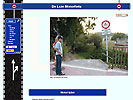
In some countries, there are exams to pass before you are allowed to ride a motorcycle; in other countries, there are even compulsary lessons to take.
In many countries, you are just supposed to learn riding a motorbike yourself. The very first lesson, is getting acquainted with a motorcycle: where is the clutch, where are the brakes?
For many people, this is all new. For them, we show what is what on a motorbike, on this page.
![]() Er is een Nederlandse versie:
Er is een Nederlandse versie:
https://www.bijzondereverrichting.nl/motor/kennismaking/
The dashboard
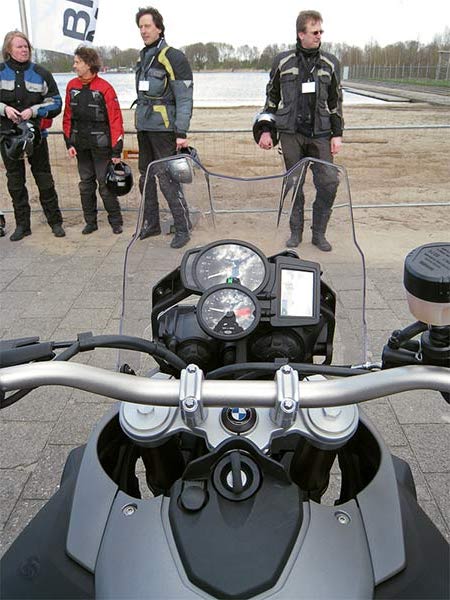
Motorcycles have a dashboard too
It sounds as something in a car, but motorcycles too have a dashboard. What features it has, differs from bike to bike.
Speedometer
Always present in a dashboard, is the compulsary speedometer. In most countries, it must be lit in the dark, in order to be able to know at what speed you ride at nighttime.
RPM meter
Most motorcycles show you the rpm's you ride as well. Rpm's stand for the revolutions per minute of your engine. It is comparable with a bicycle: how often you turn the steps around per minute, is the rpm.
This clock shows a red or orange area (in the photograph here,
you see a red area on the lower clock). That is the prohibited area
.
You are not supposed to ride with the rotations per minute in that area.
Many motorcycles won't let you do that: they shut down the throttle when you reach the red area; but on other motorcycles, it is you who has to make sure the needle does not come into the red are.
Riding with rpm's in the red area is bad for your engine.
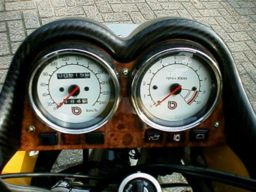
Clocks or Numbers
Both meters may be in the form of an anolog clock, like on the dashboard in this picture, but they can also have the form of a digital display of numbers.
A round clock has the big advantage that you can see in one blink of the eye, how fast yoy ride, or with how many rpm, because you will learn the relation between the numbers and the place that the needle points to in the same way as with a clock showing the time.
On these two clocks, the left one shows the speed, and the right one the rpm's (you see a red area on that one).
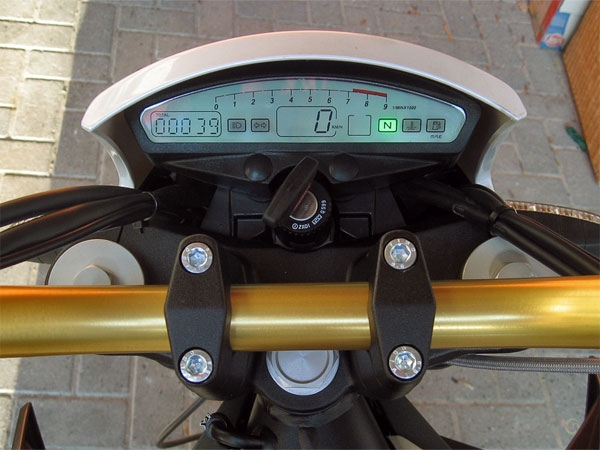
The display on this photograph shows the speed by a number (0 in this case).
It shows the rpm's through a needle (it does not show here, as the rpm's are 0), which may point to 0 to about 9000. The rider should make sure the needle never reaches 9000, because the red area starts at 7500.
Warning lights
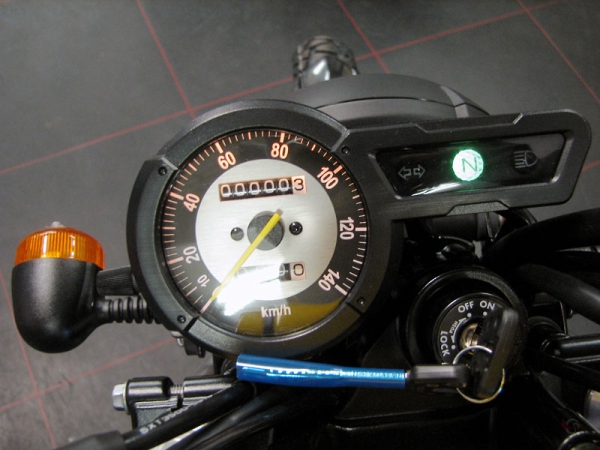
Almost all motorcycles have a number of warning lights. On this photograph, you see five of them.
When you start your bike, they are switched on for a moment, so you can check that they all work before you get on.
The most common warning lights are:
 The oil temperature
The oil temperature
When the oil temperature gets too high,
a red light is switched on.
The light often shows a thermometer.
 Instead of a light for the oil temperature, you sometimes see a warning light
for the pressure of the oil.
Instead of a light for the oil temperature, you sometimes see a warning light
for the pressure of the oil.
When warning lights for the oil are switched on, your task is to stop,
as soon as possible, on a safe spot.
 The main beam
The main beam
In general, this is a
blue light,
which reminds you to dim your lights for oncoming traffic.
 The indicators
The indicators
Many motorcycles have a warning lights for
the indicators. They blink when one of the indicators is on, so you are
reminded to switch it off after the turn.
When this warning lights blinks faster, it means that one of the lights
in the indicators is broken. The color is
green.
Neutral indication
many motorcycles show, through a
green light, that the
gearbox is in neutral (you see that warning light on the photograph of the
dashboard above).
 Sometimes, a warning light shows you that the tank is using
its reserve fuel. The light reminds you to refuel.
Sometimes, a warning light shows you that the tank is using
its reserve fuel. The light reminds you to refuel.
In the dashboard on the photograph of the dashboard of the Derbi Mulhacen,
you see a light with a fuel pomp
next to the light for the oil temperature. The color is
orange.
 You may also have a light which warns you when the
voltage of the battery is too low. The color is
red.
You may also have a light which warns you when the
voltage of the battery is too low. The color is
red.
There are more warning lights, less common than these; for ABS failure for instance.
Information display

Display
The display in this photograph has a round clock for the rpm's, but the speed is shown in numbers, in the display to the right of the clock. Not all bikes have such a display, and what the display shows varies.
As an aside, the number of 165 in this display stands for the speed. The motorcycle is parked, and the photo was taken while the display switched on the warning lights, pushed the needle through all the rpm's, and, at last, runned the speed from 0 to maximum.
Odometer
An odometer on a motorcycle is mandatory in many countries. It shows how many kilometers or miles the bike has run.
The top of the display on this photograph shows the number of kilometers (this motorcycle is very new: it has 114 kilometers on the clocks).
Day trip
Most motorcycles also have a day trip meter, which you can switch back to zero after a tank stop.
The day trip meter in this display is situated (difficult to read) next to the speed meter; the numbers also says 114.
And for the rest
Often, the display shows you in which gear you are, and often, there is something to show you the amount of fuel in the tank, as you see in this display (the fuel is shown to the right, the tank is filled to the rim in this case), or there are numbers telling you how many miles or kilometers you can ride with what is left in the tank.
The oil temperature is sometimes displayed as a number of bars, or just as the number of degrees.
Displays may offer so much information that there are, so to speak, different screens. In such a case, there will be a knob to shift between screens.
The handlebar: the mirrors

Mirrors
Mirrors on both sides are mandatory in many countries.
Because you have one on each side, and you can look over your shoulders as well, you have a broad range of view, if you make sure they are in the right position for you.
The handlebar: the start button
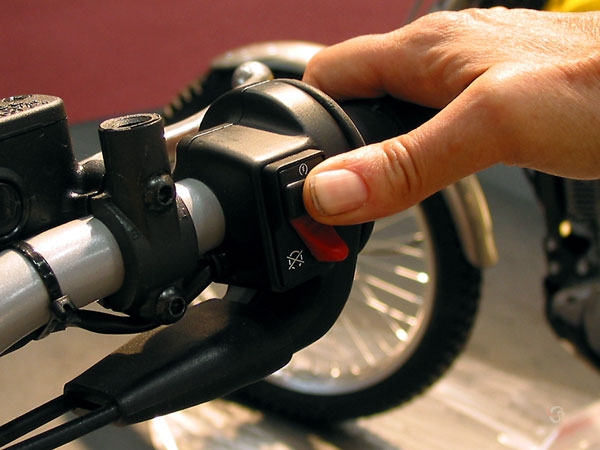
Start button: at the right
At the right side of the handlebar, you will find the start button, next to the throttle handle (see below).
In this photograph, it is the black button, which you have to press to start, after you have turned the ignition key to the right position.
Dead man's button
The red button next to the start button has the sinister name dead man's button
.
In general, you switch off the engine by turning the ignition key to the off position, but in some cases (for instance when you have fallen down) it's not possible to reach the key. In such a case, the dead man's button can be used to switch the engine off.
Impossible to start?
When your motorcycle doesn't start, always check the dead man's button first before checking for all kinds of trouble.
The handlebar: the throttle

Wheelie?
The boy in the photograph shows the international wheelie gesture.
The gesture tells you where the throttle is, and how to use it.
Right side
He uses his right hand: you use the throttle with your right hand, by turning the throttle handle around its ax.
Gas: towards you
You accelerate by turning the throttle towards you. In the photograph, you see the hand of the boy pointing downward, in a position from where he can pull his imaginery throttle open in one powerfull movement.
Shut down: away from you
You shut the throttle close by pushing the throttle handle away from you.
When you let go of the throttle, it will automatically turn to the closed position.
That means that you have to keep the throttle actively in one position to ride with a constant speed.
The handlebar: the front brake
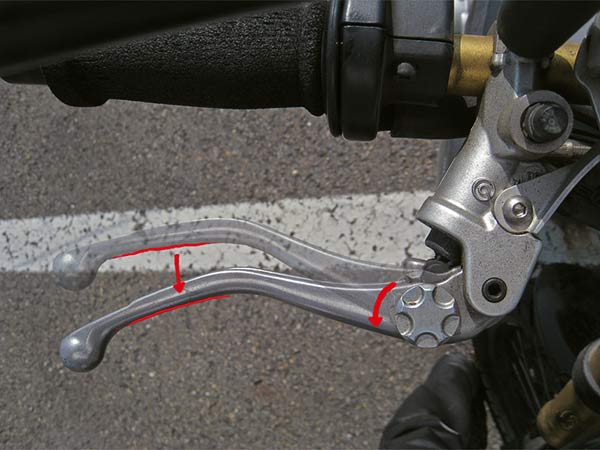
Front brake: to the right
Also on the right side of the handlebar is the handle of the front brake.
On the photograph, you observe the handle from the front of the motorcycle; not the view you have sitting on the bike.
You apply the brake by squeezing the handle.
Adjustable
On many motorcycles, the brake handle is adjustable, like you see on the photograph.
The circular knob can be turned into a number of positions, which makes the handle suitable for longer or shorter fingers.
You have to check which way you have to turn: that is different on different bikes.
The handlebar: the clutch handle
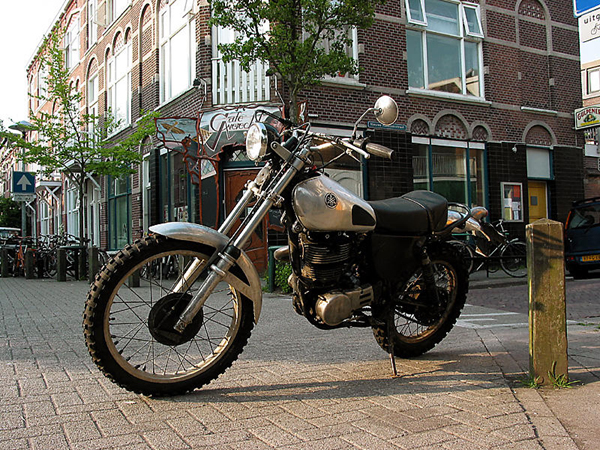
Handlebar on the left side: nothing
The handlebar on the left side does not turn, like the throttle: it is just a handlebar and nothing else.
Clutch: to the left
With the separate handle on the left, you apply the clutch.
Pulling this handle (against the handlebar) means that you disengage; by letting the handle go, you engage.
The handlebar: the switch for the indicators
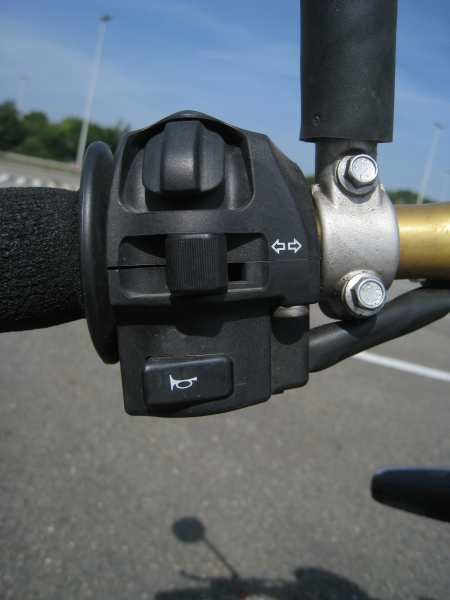
Left
On most motorcycles, the switch for the indicators can be found at the left side of the handlebar, as in this picture, of the Derbi Mulhacen.
You apply the indicators by switching to the left or the right. You turn of the indicators by pushing the knob in the middle.
Not automatically
On most motorcycles, you are responsible for switching off the indicators. There are some exceptions that have a sensor (on a motorcycle, the handlebar does not turn in a corner, so it is more difficult to build in an automatic switch-off).
BMW: different
BMW uses another kind of switch for the indicators. There are two switches to engage the indicators: one for the right (on the right side of the handlebar), and one for the left (on the left side). There is a third switch (at the right side of the handlebar) that you have to push up with your thumb to turn them off.
Horn
In this picture, you see the switch for the horn below the switch for the indicators.
This is the most common place for this switch.
Joystick
The joystick
above the switch for the indicators is to switch between
different functions of the display. The place for this function is
not standard. On many displays, there are buttons below the display itself
to choose different functionality.
The handlebar: the controls for the lights
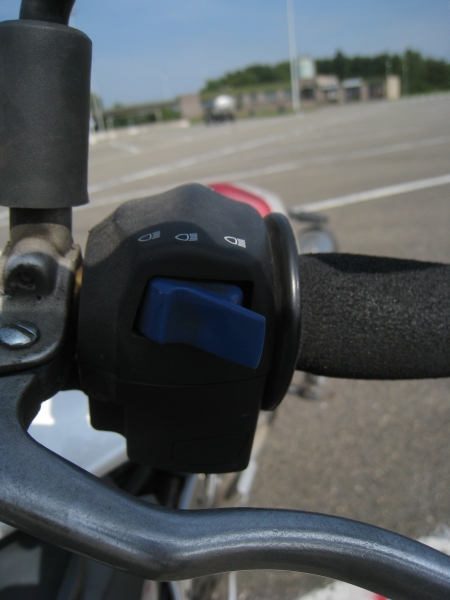
Left
The switch for the main beam is often on the left side.
Here, you see the switch of the Derbi Mulhacen.
On, off and signal
In this case, the main beam is switched on by pushing the switch to the front, and off by pushing it back.
You can signal by pushing the switch against the handlebar and back.
Dipped beam
Often, there is no switch for the dipped beam: it is automatically switched on when the engine starts.
Parking light
Often, there is a position on the ignition lock which switches on the parking light.
The Footpegs: the Gear change lever

Footpeg at the left side with the gear change lever
You change gears with your foot, your left foot.
In the picture, you see the gear change lever a bit in front of the footpeg.
So, changing gears is done with your toes.
Into first: downward
From neutral, you change into the first gear downward.
The rest: upward
From the first gear, you change into a higher gear by holding your toes under the gear change lever and push it upwards; to change into a lower gear, you push the lever downward.
Footpegs: the Brake lever
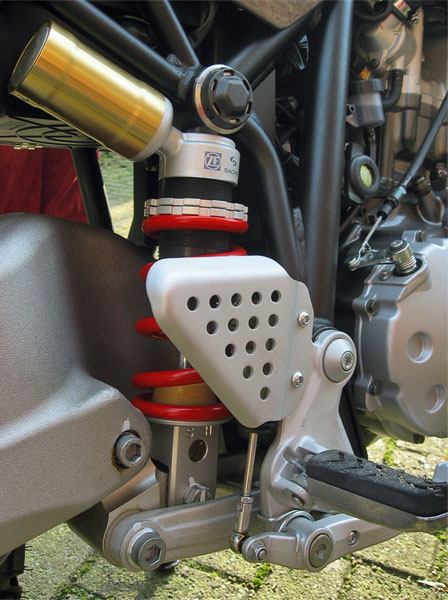
Footpeg on the right with the brake lever
At the right side of the bike, you find a brake lever instead of the gear lever. This lever is for the rear brake. You use the rear brake by pushing the lever down with your toes.
In the picture, you see the small ax, below the footpeg, wich is connected to the brake lever.
Carefull
Because your toes are less sensitive than your fingers, you should be easy on the rear brake.
Especially if you are a car driver, you will have to oppress the tendency to push your right foot down, from time to time!
The tank cap
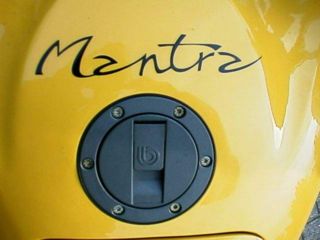
Locked
Tank caps are locked, in most cases, with the key for the ignition lock.
Often, the tank cap is where you expect it to be, as on the Bimota Mantra: in the tank, in front of the seat.
Sometimes below the seat
But there are motorcycles (The BMW F650GS for instance) with a tank below the seat, to bring the centre of gravity downward. What looks like a tank on those bikes isn't a tank, so the tank cap is found on a different place than you expect.
The ignition lock
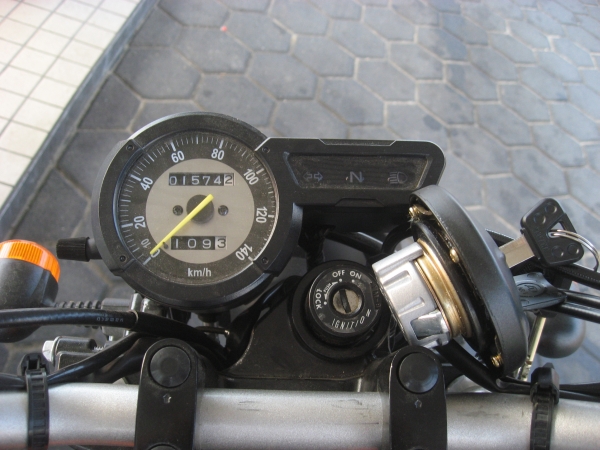
In front of the handlebar
On most motorcycles, the ignition lock is found in front of the handlebar, as in this case.
Three positions
You can see three positions for the key, in this picture: on, off and lock. The last position is to lock the handlebar.
Other places
In some pictures above, you see that the ignition lock can sometimes be found behind the handlebar, just before the tank. There are other places as well: on cruisers, the ignition lock is often somewhere at the side.
Loose tank cap
In this picture, you see a loose tank cap. On most motorcycles, the tank cap can not be taken off, but can be moved upward: there is a hinge on one side.
The brake discs
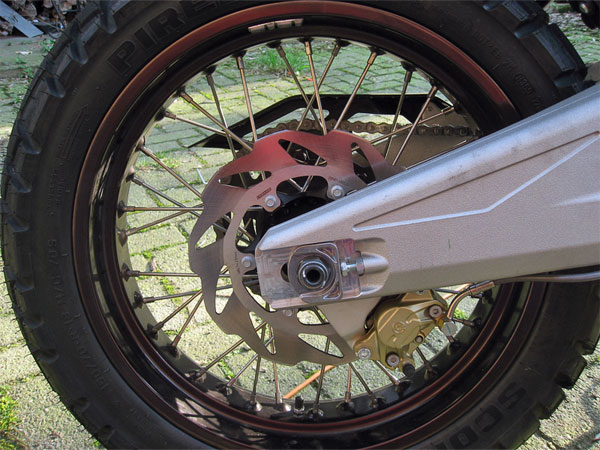
Disc brakes or drum brakes
Motorcycles used to have drum brakes. Nowadays, almost all have disc brakes. Once in a while, you still see a drum brake at the rear.
Front and rear
The disc in the picture is from the rear. In the front, you see sometimes a single, and sometimes a double brake disc. In that case, you see a disc on both sides of the front ax.
The cylinder(s)
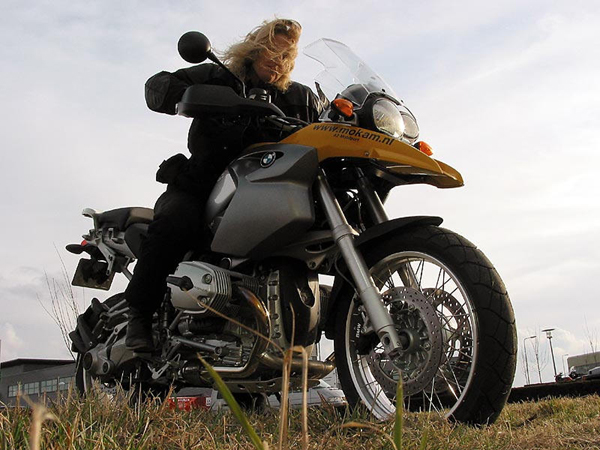
And where are the cylinders?
Of course, it is nice to know where you can find the cylinders on a motorcycle: they form the heart of the engine.
They are very easy to spot in this BMW: it has its cylinders
sticking out to both sides. The thing
in front of the
shin of the rider is the cylinder at the right side.
Not always as easy to spot
In most motorcycles, it's a somewhat harder job to find the cylinders.
In the (one cylinder) Yamaha XT500 in the picture about the clutch lever, you see the ribbed cylinder below the tank. The ribs are there for cooling reasons.
Comments, Q & A, on a separate page




